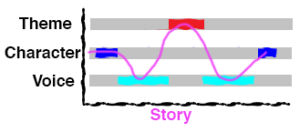“This story just needs… more,” the editor said. “It feels thin.”
Thanks, I thought, that’s not quite the vaguest advice ever. But then my husband turned it around for me with a metaphor.
Hubby and I were talking about stories having channels, like sound channels in a music composition. This is best to visualize as it is in programs like Garage Band (or Rock Band!) with bars of color corresponding to when each instrument plays.

(Yeah I used the line and block tools in photoshop and the ripple filter in a cheap effort to make it look ‘hand drawn’. Shush.)
The channels will be different for different stories, but say one story has Character, Plot, and Theme channels. Another might have Local Color, Science Concept, and Conflict channels. So our sample story here, has Theme, Character, and Voice.
Now, thinking about these channels, you start writing. You start out with a paragraph about your main character, then some beautiful narration, then a chunk of thematic material. That’s okay. It’s a good way to start out writing, but your draft ends up like this:

I think this is what was happening in a “thin” story. The editor couldn’t put his finger on what was wrong, but when I re-read the story, I got the same vague vibe. The story was thin. What does that mean?
I don’t think it’s a coincidence that other first readers said the story was ‘jarring’ or ‘disconnected’. This is because the through-line of the story, the actual writing, was jumping back and forth between tracks:

Really, almost every paragraph needs to do double duty… y’know? So that the story feels rich, like a song with both drums and guitar going feels thicker, richer, than just the guitar or just the drums.

And, like music, sometimes you have to back off. Give the reader some air, let your setting have its guitar solo. Add another track just at the end, like the gong at the end of “Nights in White Satin”. It’s all rock and roll, baby!
You know what I just realized, while drawing these diagrams?
When you layer your channels, the experience of the story is smoother. Imagine it like listening to music – the guitar over the drums… they blend together. The voice will pull the centerline, the theme will pull the center line, but so long as they are not alone, they don’t pull it too far from center… yeah, that’s pretty groovy, eh?

So I took my story that felt ‘thin’ and I marked it up. I highlighted all character moments and setting moments and science fiction thingy moments, and I saw where I could layer them more. We’ll see if that helped?
Mileage may vary. Will not help with all stories. May not even help with any stories. This advice is for visualization of problems only. Take only as directed.



2 Comments
Nyla · June 30, 2016 at 12:56 pm
This is not spam. 🙂
Really good example.
Marie · July 6, 2016 at 3:40 pm
*mwah* Thanks, hon.
Comments are closed.